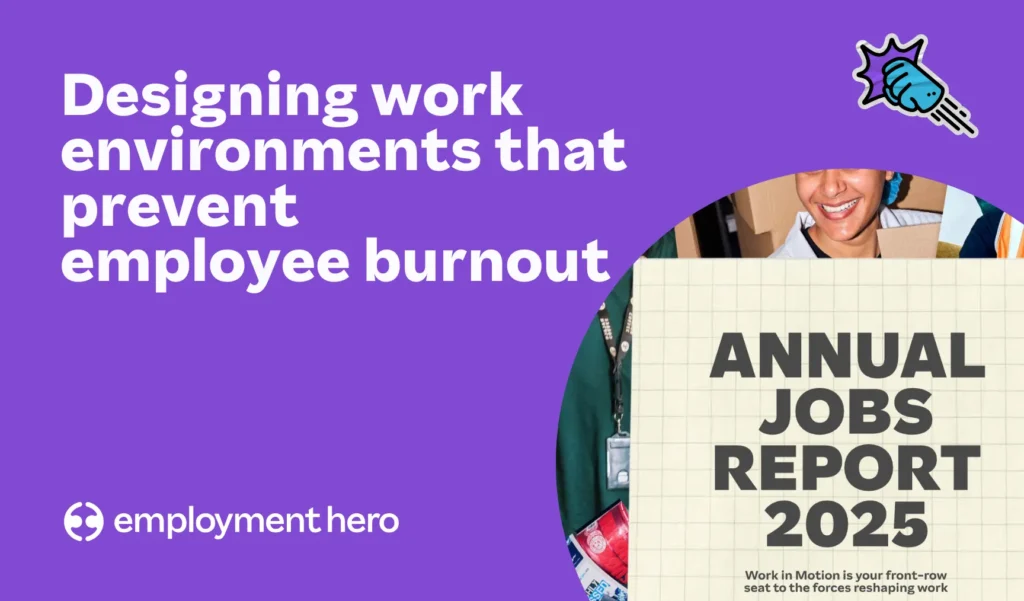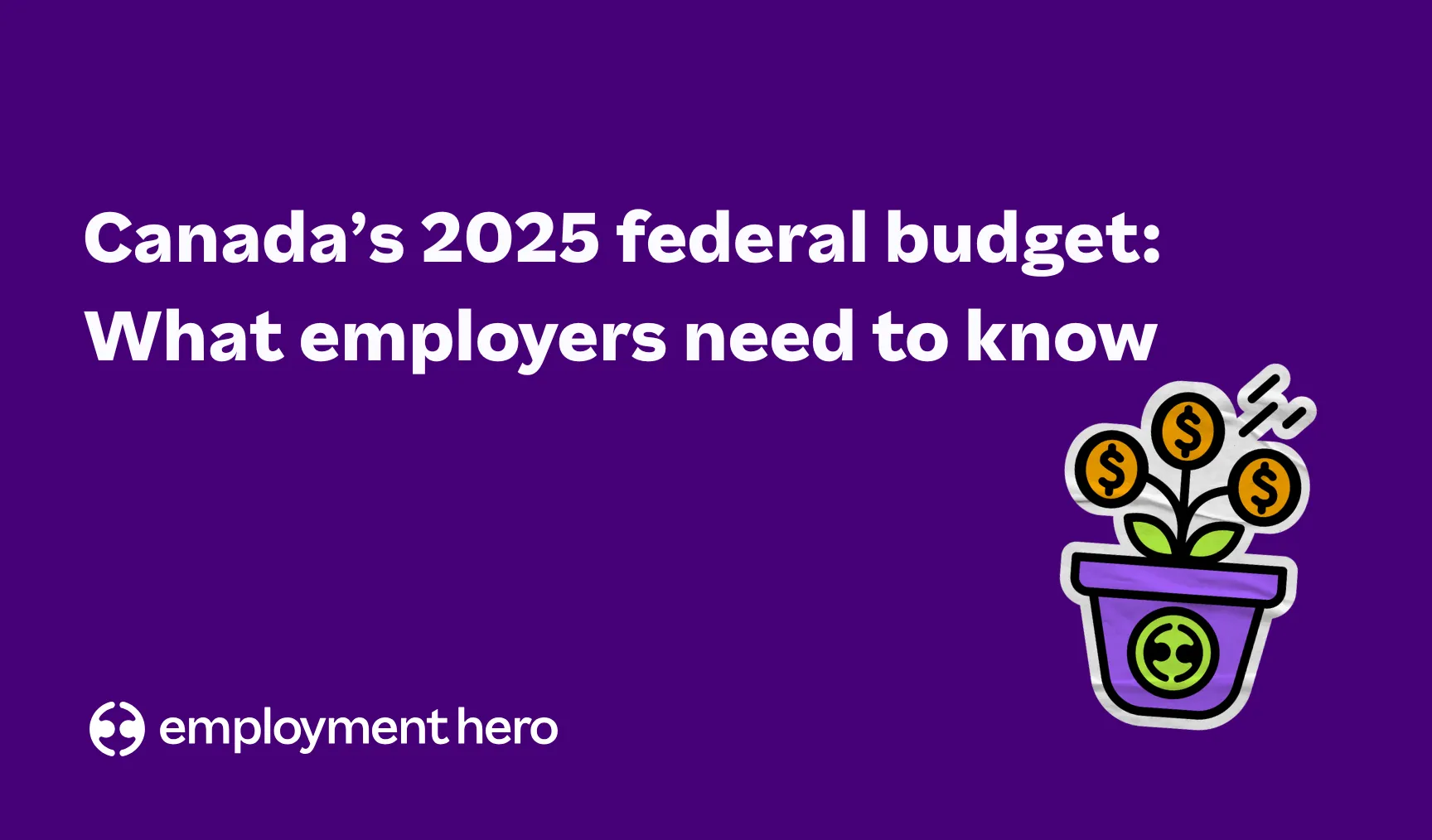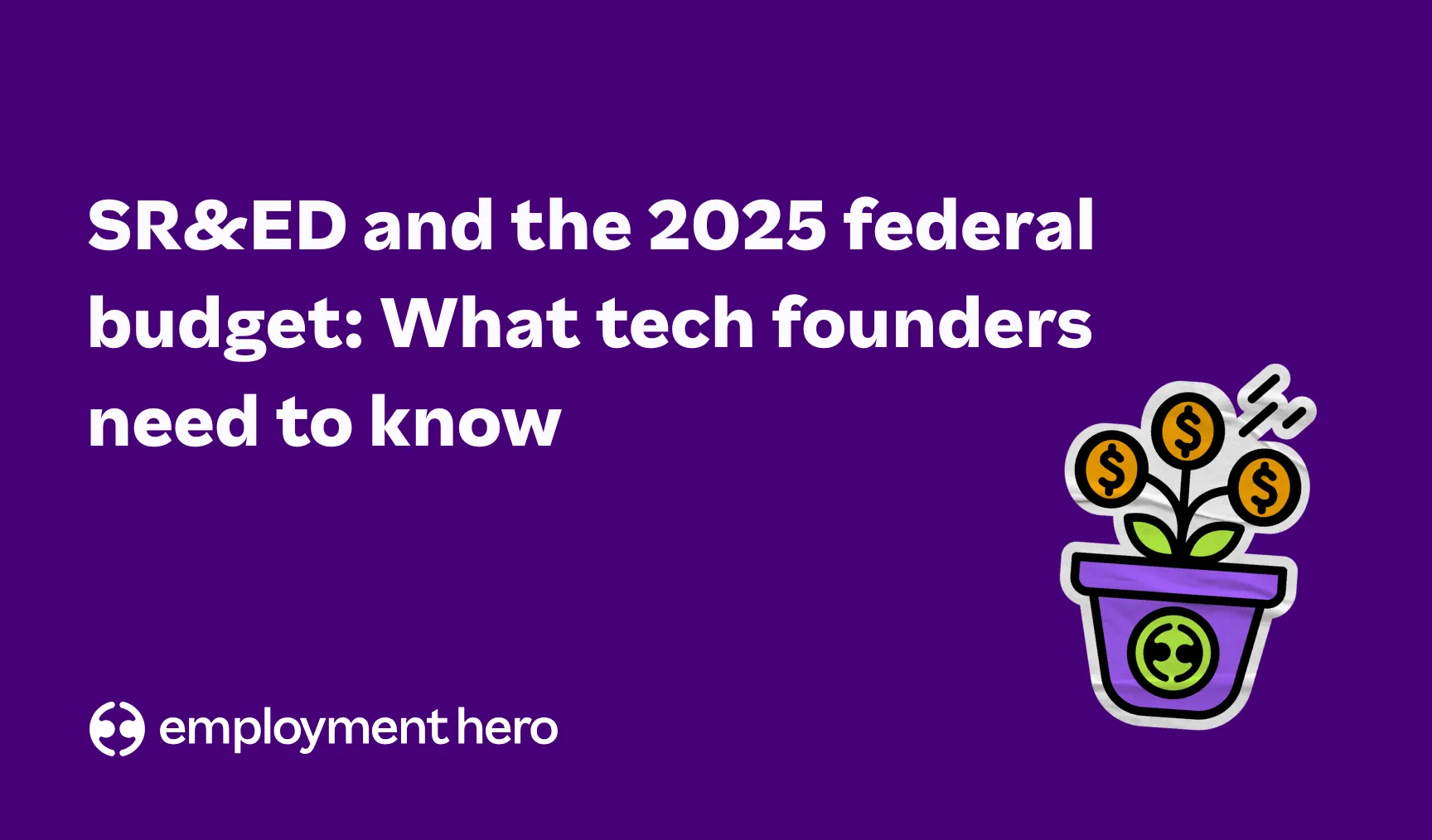Designing work environments that prevent employee burnout

Contents
Employee burnout is a real risk for Canadian SMBs. It shows up when pressure keeps rising and recovery time keeps shrinking. People run out of energy. They disconnect. Work slows down. When a small team loses even one person to burnout, everyone feels it.
Employment Hero’s 2025 Annual Jobs Report highlights the backdrop. Thirty-five per cent of Canadians with a full-time job are also working additional roles. Fifty-three per cent want jobs with less pressure and responsibility. That mix creates strain. SMB owners and HR leaders need a plan that turns the workplace into a buffer, not a stress multiplier and an all-in-one HR software like Employment Hero can help build that foundation.
Workplace burnout in Canadian SMBs: what it looks like and why it spreads
Workplace burnout builds over time. The signs are clear if you’re watching for them. Exhaustion looks like low energy most days, a slower pace and more small mistakes. Cynicism shows up when employees pull back from team chats or lose interest in goals. Reduced confidence is another red flag, marked by avoiding new tasks, second-guessing simple work and missing deadlines.
In SMBs, burnout spreads quickly. Workloads shift to cover gaps, adding pressure to the rest of the team. Decisions slow down, which creates last-minute rushes and even more stress. Negativity also travels fast in small groups — a single frustrated voice can set the mood for everyone. Prevention starts with spotting these patterns early and acting fast.
The financial case for preventing employee burnout
Employee burnout drains time and money. Burnout often leads to sudden departures, leaving teams scrambling. Hiring takes time, pulls focus from other priorities, and puts extra strain on the budget. Onboarding new people then takes months. Client relationships can wobble in the midst. Even without turnover, productivity dips and absenteeism rises. For a small business, these costs compound.
At the end of the day, prevention costs less than recovery. So how do you make the case for prevention?
Show the value in terms that leaders can’t ignore:
- Track hiring and onboarding time, then multiply by hourly rates to uncover the true cost of churn.
- Keep an eye on overtime hours and sick days — spikes often point to stress hot spots.
- Project delays tied to rework or constant context switching are another signal. Fewer switches mean fewer delays. Put all of this into a simple dashboard and share it with leaders.
Treat prevention like any other core project: with goals, owners and accountability.
Burnout prevention strategies for a healthier workplace
Below are seven design choices. Each one includes actions you can roll out this quarter.
1. Create a safe work environment
People speak up when they feel safe. That stops small issues from turning into full burnout. Run quick pulse checks every 90 days, keeping them short with just a handful of questions on workload, support and energy. Train managers to ask two simple one-on-one questions: What feels heavy right now? Where do you need help this week? Make sure your handbook spells out a clear escalation path — who to call, how fast they’ll respond and what happens next.
In practice, safety looks like managers thanking people for raising risks and moving straight to solutions instead of blame. It looks like leaders ending meetings with a quick check-in: Anything unclear? Anything we should stop doing? Trust builds when the real questions are asked, and action follows.
2. Support work-life balance every day
Policies alone don’t create balance — daily behaviours do. Protect quiet hours. For example, set a rule of no meetings before 10 am so mornings can be used for deep work. At the start of each quarter, map out time-off and coverage against major deadlines to avoid last-minute scrambles. And shut off push alerts on shared channels after hours; true emergencies should follow a phone tree, not a late-night ping.
Healthy signals show up in small ways. People use the focus blocks on their calendars. Managers approve vacation requests promptly and plan ahead for coverage. Over time, after-hours messages become rare exceptions instead of the norm. When employees see these behaviours day to day, they start believing rest is part of the job.
3. Redefine career growth to boost employee engagement
Many Canadian workers want development, not heavier workloads. Build growth paths that reward expertise without forcing people into management. And when you’re ready to expand, Employment Hero’s Hiring software connects recruitment with HR so growth stays sustainable.
Add a senior specialist track alongside the manager path, with clear levels, pay bands and impact examples. Launch quarterly spotlights where peers nominate colleagues for craft excellence, mentorship, or problem-solving. Offer lateral projects to expand skills, but limit them to one at a time so workloads stay reasonable.
Contribution should be recognized fairly. Tie pay rises to impact and mastery, not team size. Share short “win” write-ups on your company feed so recognition is visible to all. When employees see their strengths celebrated, engagement grows.
4. Strengthen employee engagement with purpose
Employee engagement grows when people see why their work matters. That starts with clear goals everyone can understand, not jargon-filled scorecards. In meetings, connect tasks to outcomes employees care about — like money saved, customers helped, or risks reduced. Pair learning opportunities with real projects so new skills feel relevant, not abstract. And keep reinforcing that purpose over time. When leaders share wins and explain the impact of the team’s effort, employees see the link between their work and the bigger picture. That’s what keeps energy and commitment high.
5. Design workloads for sustainable performance
Sprints of effort are fine. Endless sprints damage morale. Sustainable performance protects long-term capacity. Set a work-in-progress limit per person, like no more than three active priorities. Run capacity checks before kicking off new projects, accounting for holidays and crunch periods. Cut meetings by defaulting to 25- or 50-minute blocks and replacing status calls with shared notes or recordings when possible.
Daily routines also help. A five-minute morning stand-up clarifies what’s being done, what’s blocked and what’s needed. A two-minute end-of-day check resets priorities for tomorrow. These small rituals keep workloads steady and stress in check.
6. Coach HR leaders and people managers as energy protectors
Managers shape the day-to-day experience. Equip them to prevent workplace burnout. Provide a simple playbook covering how to balance workloads and say no when needed. Add a monthly manager forum where real cases and solutions can be shared. Track key habits like one-on-ones, recognition frequency and time-off approvals.
Strong management looks like clear priorities with no surprise deadlines. It looks like specific, timely recognition and quick action when cracks in capacity appear. Managers are the frontline defence against burnout.
7. Measure employee well-being and act on results
Measuring well-being is part of leadership. Useful metrics include energy and workload scores from pulse surveys, overtime hours per team, meeting hours per person and time to backfill or onboard new hires. Review these monthly and share highlights openly. Then pick one change to test and report back on progress.
Employees notice when measurement turns into meaningful action.
Company culture that shields against burnout
Strong company culture is a long-term defence against burnout. It turns values into habits. Clarity, fairness and learning are the anchors. Every role needs a purpose and a few priorities. Workloads should match capacity, and recognition should match effort. Mistakes should become lessons, and lessons should become playbooks.
Keep culture visible with a short new-hire guide that takes less than ten minutes to read, a monthly “we ship what we promise” award tied to teamwork and a public backlog of culture fixes with clear owners and due dates. Culture isn’t what’s written on the wall — it’s what people feel every day.
What HR leaders can do this quarter
This quarter doesn’t need a full overhaul. Quick wins show progress and build momentum.
- Publish quiet hours and meeting norms that set clear boundaries and protect focus time.
- Add quarterly time-off planning with coverage maps so teams can see who’s away and avoid last-minute scrambles.
- Use a one-page goal template across all teams to keep priorities visible and aligned without extra admin.
- Launch a senior specialist path with example profiles showing employees they can grow expertise without being forced into management.
- Build a rhythm of recognition through weekly shoutouts and monthly spot bonuses so appreciation becomes part of the culture, not an afterthought.
- Train managers to spot burnout signs early, giving them the tools to rebalance workloads before problems spiral.
These steps alone will already create a visible shift. If you’re ready to go further, add dashboards for overtime, meetings and hiring time so leaders can see stress points at a glance and make faster adjustments. Employment Hero’s Time & Attendance software gives Canadian SMBs these insights instantly.
And finally, cut noise by removing one tool that duplicates work, like two apps managing the same tasks. Consolidating tools saves time, reduces confusion and helps employees focus on what matters.
How technology can reduce workplace burnout
Technology should simplify, not complicate. For many SMBs, the first step is automating repetitive admin — things like time-off requests, approvals and reminders. When those tasks are off managers’ plates, they can focus on coaching and supporting their teams instead of chasing paperwork. The same principle applies to payroll.
Employment Hero’s Payroll software takes the pressure off by streamlining compliance, pay runs and reporting for Canadian teams. Pair that with a single platform for goals, feedback and recognition, and you’ve got a clear source of truth. With less time wasted on manual updates, everyone can focus on the work that actually moves the business forward.
Set clear communication rules so quick questions go to a Slack channel, tasks requiring action go into the project tool and wins are shared where everyone can see them. When tools are consistent and easy to navigate, and use expectations are clear, teams stop context switching and start focusing on work that matters. The payoff is less clutter, more focus and faster progress.
Supporting employee resilience and recovery
Employee resilience grows with practice and support. Short workshops on focus, stress and sleep give people practical tools. Peer circles that meet monthly create space to share challenges and ideas. Pairing new hires with mentors for their first ninety days helps them start strong.
When burnout does happen, recovery needs structure. Scale back workloads, agree on a step-by-step return plan and increase one-on-ones for a season. Celebrate progress along the way — the first week back, the first project shipped, the first customer win. Recovery isn’t about working harder, it’s about pacing smarter.
Ready to put burnout prevention on rails? See how Employment Hero supports employee engagement, work-life balance and fair workloads for Canadian teams.
The Canadian context: why this matters now
Canada’s workforce is in motion, and the pressure is visible. Many Canadians are juggling more than one job just to cover rising costs. At the same time, over half say they want roles with less responsibility and less pressure. That combination drains energy fast and leaves little room for long-term growth.
SMBs that design around human limits — by protecting rest, balancing workloads and offering flexibility — won’t just retain their people, they’ll stand out as employers of choice in a competitive labour market. They’ll also build teams resilient enough to handle change without constant fire drills. Leaders who act now can set the tone for the year ahead: clear norms, fair workloads, real rest and visible growth. These choices send a powerful signal that wellbeing isn’t optional — it’s built into how the business runs.
Pulling it all together
Burnout prevention isn’t a side project — it’s the way resilient businesses are built. It starts with safety, fair workloads and protected time. It grows when you reward mastery, measure wellbeing and adjust fast. None of these steps is complicated on its own, but together they transform the employee experience.
The payoff is clear: teams with energy deliver better work, stay longer and give more to customers. For SMBs, that means lower turnover, stronger loyalty and a culture that can weather change. Investing in prevention isn’t just good for people — it’s a smarter way to run the business.
Ready to design a workplace that prevents burnout and builds sustainable performance? See how Employment Hero helps Canadian SMBs protect their people and grow stronger teams.
FAQs on preventing employee burnout in Canadian SMBs
Heavy workloads, low control, unclear goals and constant context switching. Rising living costs add pressure for many Canadians.
More sick days, slower replies, missed hand-offs, shorter tempers and quieter voices in meetings.
People raise issues sooner. Managers can rebalance work before stress turns into burnout.
Quiet hours, planned coverage for holidays, fewer meetings and fast approval of time off.
When work feels meaningful and progress is visible, energy lasts longer and stress feels manageable.
Adjusted workload, clear milestones, more frequent check-ins and support from a mentor or coach.
Pulse scores on energy and workload, overtime hours, meeting load and time to fill roles.
Everyone has a role. HR leaders set the system. Managers protect capacity. Teams speak up and help refine the plan.
Related Resources
-
 Read more: 8 Email Holiday Templates for Every Workplace
Read more: 8 Email Holiday Templates for Every Workplace8 Email Holiday Templates for Every Workplace
Struggling to write your out-of-office message? Copy our 8 free holiday email templates for Christmas and New Year to set…
-
 Read more: 2025 federal budget: What Canadian employers need to know
Read more: 2025 federal budget: What Canadian employers need to know2025 federal budget: What Canadian employers need to know
Discover what Canada’s 2025 federal budget means for employers, from enhanced SR&ED incentives to new talent and funding opportunities.
-
 Read more: What tech founders should know about the 2025 federal budget and why this year is the perfect time to double down on SR&ED
Read more: What tech founders should know about the 2025 federal budget and why this year is the perfect time to double down on SR&EDWhat tech founders should know about the 2025 federal budget and why this year is the perfect time to double down on SR&ED
Discover how the 2025 federal budget enhances SR&ED for Canadian startups. Learn how founders can maximize refunds, extend runway and…


















